Why do my listwidget items disappear sometimes when i resize the dialog?
Before:
After:
import os, sys, json
sys.path.append('Z:\\pipeline\\site-packages')
from PySide import QtGui, QtCore, QtSvg
################################################################################
# Custom Widgets
################################################################################
class LayerWidget(QtGui.QWidget):
def __init__(self):
super(LayerWidget, self).__init__()
# controls
self.ui_thumbnail = QtGui.QToolButton()
self.ui_thumbnail.setToolButtonStyle(QtCore.Qt.ToolButtonTextUnderIcon)
self.ui_thumbnail.setFixedSize(128,128)
self.ui_thumbnail.setIconSize(QtCore.QSize(80,80))
self.ui_thumbnail.setText('TITLE HERE')
self.ui_profiles = QtGui.QComboBox()
self.ui_profiles.addItems(['Item 1','Item 2','Item 3'])
# layout
main_layout = QtGui.QVBoxLayout()
main_layout.setContentsMargins(0,0,0,0)
main_layout.setSpacing(0)
main_layout.addWidget(self.ui_thumbnail)
main_layout.addWidget(self.ui_profiles)
main_layout.addStretch()
self.setLayout(main_layout)
class LayerManager(QtGui.QWidget):
def __init__(self):
super(LayerManager, self).__init__()
self.resize(400, 500)
self.ui_layers = QtGui.QListWidget()
self.ui_layers.setViewMode(QtGui.QListWidget.IconMode)
self.ui_layers.setResizeMode(QtGui.QListWidget.Adjust)
self.ui_layers.setEditTriggers(QtGui.QAbstractItemView.NoEditTriggers)
self.ui_layers.setMovement(QtGui.QListView.Static)
self.ui_layers.setIconSize(QtCore.QSize(96,96))
self.ui_layers.setSpacing(10)
main_layout = QtGui.QVBoxLayout(self)
main_layout.addWidget(self.ui_layers)
def add_new_layers(self):
for x in range(4):
widget = LayerWidget()
item = QtGui.QListWidgetItem()
self.ui_layers.insertItem(self.ui_layers.count(), item)
self.ui_layers.setItemWidget(item, widget)
item.setSizeHint(widget.sizeHint())
################################################################################
# Main Window
################################################################################
class MainWindow(QtGui.QMainWindow):
def __init__(self):
super(MainWindow, self).__init__()
self.setWindowTitle('Hyv')
self.resize(500, 500)
self.ui_layerManager = LayerManager()
self.setCentralWidget(self.ui_layerManager)
self.ui_layerManager.add_new_layers()
################################################################################
# Launch Methods
################################################################################
def main():
app = QtGui.QApplication(sys.argv)
ex = MainWindow()
ex.show()
sys.exit(app.exec_())
if __name__ == '__main__':
main()

